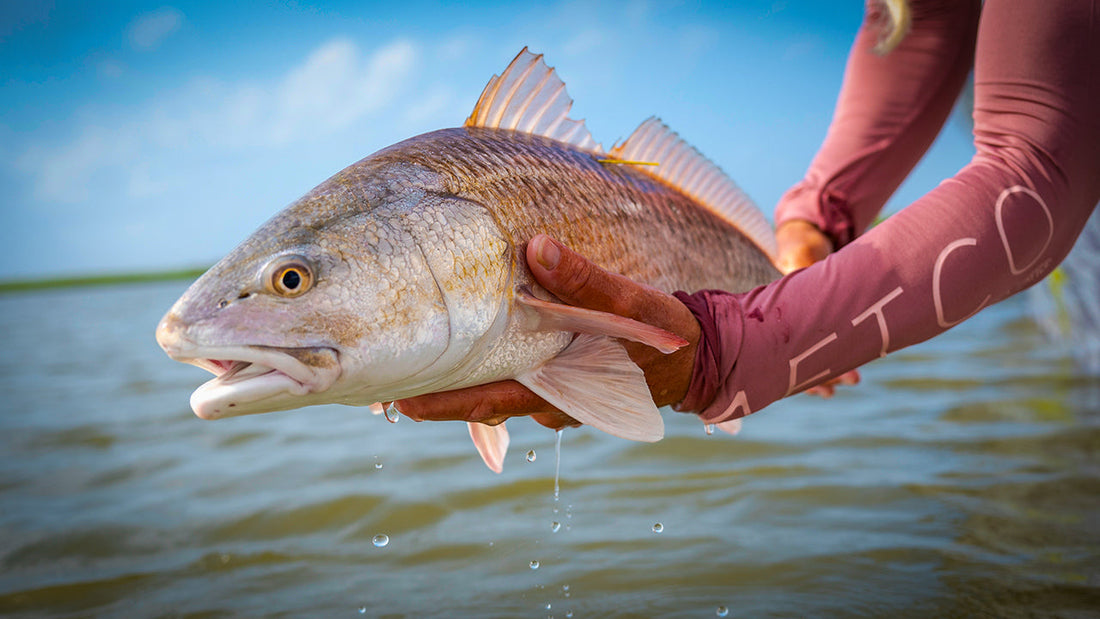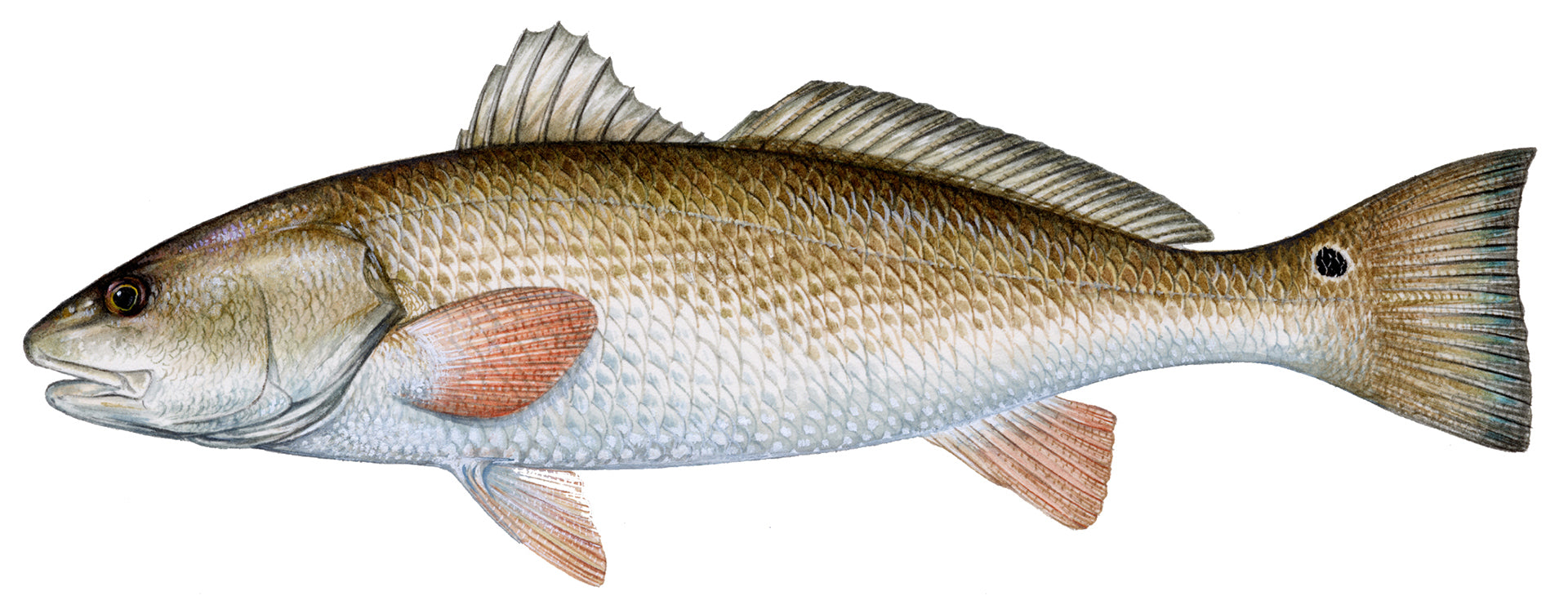
Species Spotlight: Redfish
RED DRUM (Redfish)
Sciaenops ocellatus

Few large inshore gamefish have the depth of geographical range, like redfish, a mainstay for anglers from Virginia to Texas. In this region, reds are one of the most accessible and prized species. They strike live baits and lures (including topwaters) readily and ferociously, making strong, determined runs until anglers can wear them down. Red drum travel in schools and as solo predators — sometimes visible as vast swaths of bright rust-colored water.
Decades ago, redfish were overfished in most of the South, partly because of the Cajun craze for blackened redfish that swept through the region and beyond. Simultaneously, gillnetting laws coupled with tightened size and bag limits helped stabilize the redfish population, leaving populations generally healthy today. Like many gamefish, the economic value of redfish in recreational fishing is substantial.
Appearance
More appropriately, a red drum would be called a “reddish drum,” but that’s awkward. The red drum tends to be coppery with reddish overtones, even tending toward brilliant gold in some areas. However, they may also be a more muted silvery color. Just before the tail fin, the black, gold-rimmed “eye spot” on the upper caudal peduncle is another trademark. Often, redfish display more than one of these distinctive marks, occasionally with many along their sides. Their elongated shape is a characteristic of the family of drums and croakers (Sciaenidae) that they are a part of.

Habitat
Few gamefish thrive in as many habitats as redfish. Anglers can find reds on flats and in mangrove estuaries, in channels, inlets, and bays, in the surf of Atlantic beaches, and offshore around structures (such as oil rigs) in waters as deep as 200 feet and more. Smaller fish thrive on eelgrass flats and in shallower bays. Larger mature fish prefer to migrate deeper, often outside waters where they form schools over sandy-bottom areas.
Size
Redfish vary in size. Inshore, redfish commonly weigh 2-15 pounds and get up to 20-40+ pounds along beaches and inlets. As they migrate, big bulls become available seasonally in most areas. However, no angler has beaten the IGFA all-tackle world record. Since November 1984, the record has been held by angler David Deuel, who wrestled a 94-pound, 2-ounce monster drum onto the sand on an Atlantic beach near Avon, North Carolina.

Fishing for Redfish
Anglers targeting redfish can use a variety of tactics, baits, and lures. Successful techniques will vary based on the depth, range, and habitat though.
Many redfish succumb to mullet (live or cut), shrimp, or crabs when bait. Otherwise, redfish love lead head jigs and plastic tails. They also readily go after diving lures, and beating their strikes on surface lures is hard. Their slightly underslung mouth can require multiple strikes to latch onto a bait firmly. In areas like southwest Florida and eastern Florida's Indian River, anglers can take advantage of exciting sight fisheries with some great opportunities for fly-rod anglers. Even in more opaque waters, if shallow, reds often give away their location with tails waving above the surface as they hunt for food.

Redfish Pros
Available and accessible to large and small boats. Also, for shore/wade anglers from Virginia to Texas.
Tough, persistent fighters
Caught on an almost endless array of lures and baits
Good flyfishing targets in some areas
Redfish Cons
They can become finicky and easily spooked, mainly where schools of reds are fished heavily.
If caught offshore in deeper water, reds may suffer barotrauma more than many other species, making release difficult when taken from 60 to 80 feet or more. Knowing how to hold a fish for catch and release greatly impacts the health of your catch. Captains Moe and Eric Newman have seven tips for handling fish so anglers can do their part to ensure that fishing is available for generations. The Release Glove and Titan Landing Net are two go-to items for guaranteeing a successful catch and release. See the Titan Landing Net in action below.

Anglers have the responsibility to be stewards of conservation and to help maintain redfish populations so they stay healthy. To keep redfish populations strong, AFTCO has helped pioneer Louisiana's first-ever redfish stocking program in partnership with the Recreational Fisheries Research Institute. RFRI plans to release approximately 100,000 two-inch redfish fingerlings across coastal Louisiana through their science-driven approach in 2025. To learn more about this groundbreaking project, click here.
Whether fishing inshore or offshore for redfish, ensure you have the proper clothing to take on the elements. Check out our offshore fishing guide to stay comfortable, no matter the conditions. Best of luck on the water chasing reds.






